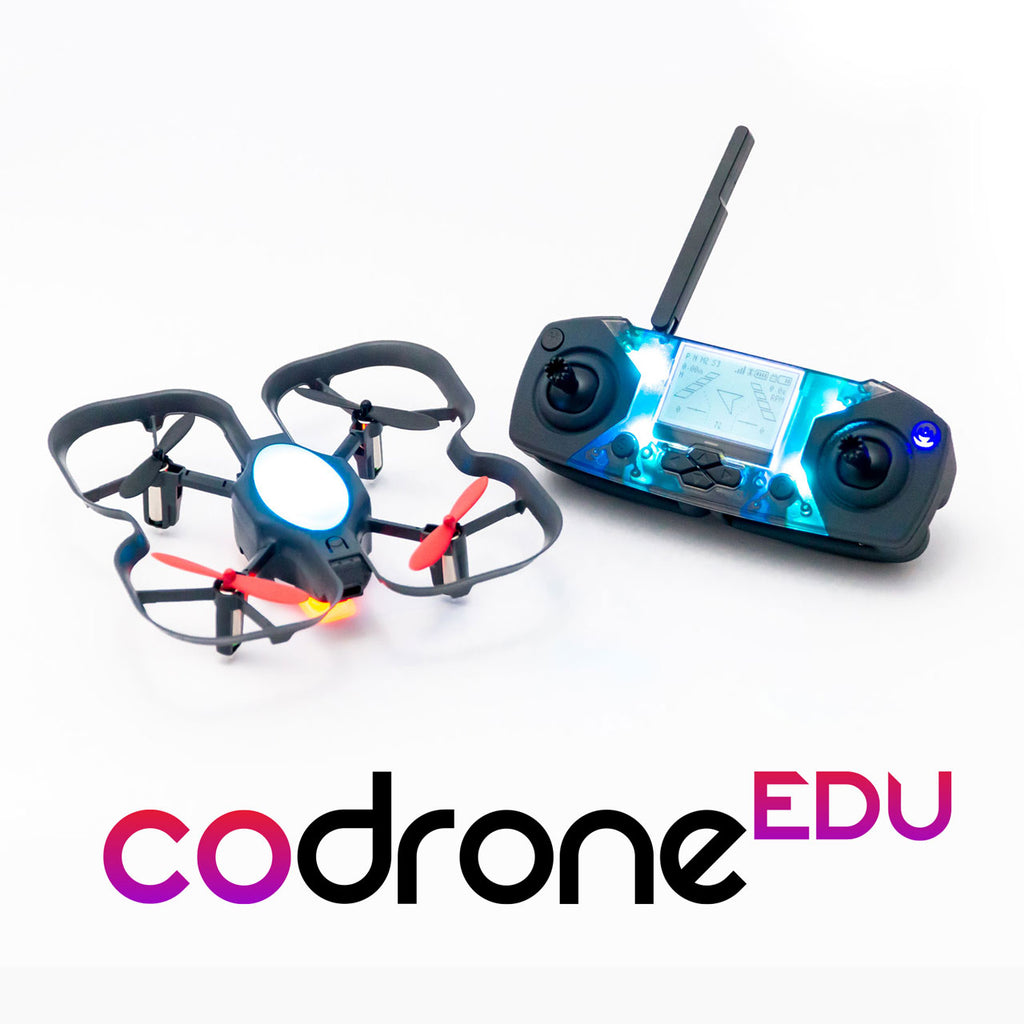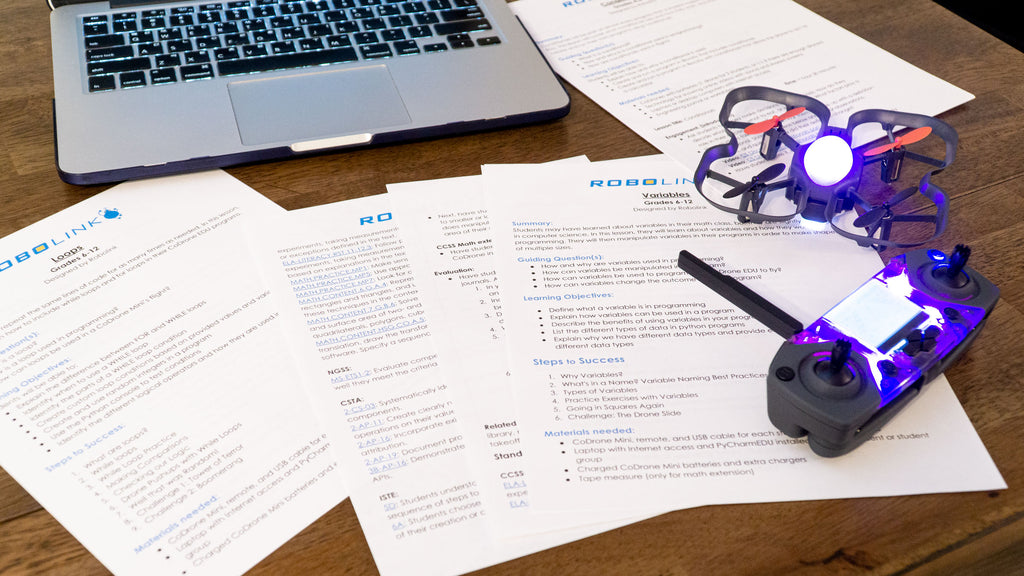
CoDrone EDU, and What Makes it Different
CoDrone EDU, and What Makes it Different
The CoDrone EDU is finally available to pre-order in our store!
Wes here! I'm Chief Product Officer here at Robolink. After many months of testing and iterating, testing again and iterating again, the CoDrone EDU is finally here. Our Kickstarter campaign officially closed on March 17, 2022. We raised a total of $76,641! That's 7.6 times our original goal of $10,000.
Ok, so which drone should I get?
How does the CoDrone EDU compare to our 2 previous drones: the CoDrone Mini in 2020, and the CoDrone Pro in 2016? I put together this handy dandy comparison chart, which I think will help make it much clearer.

- Much more stable signal stability with multiple drones in the classroom
- Pairing only needs to be done once
- Flight time is 2 minutes longer on the CoDrone EDU
- Controller has an LCD screen, which opens up tons of potential sensor data and visualization
- Drone has the ability to make sounds
- It can flip!
- Ability to do swarms and control multiple drones with one computer
- Better quality sensors, more sensors
The main recommendation I can make is this: if you want something smaller, more affordable, and easily approachable for younger students, I would recommend the CoDrone Mini. It's a fantastic introduction to coding something that can fly and move in the physical world. If you want something that's a step up, with additional and better sensors, more stable and precise flight, I would definitely recommend the CoDrone EDU. It does everything the CoDrone Mini can do, but better. It also has a ton of additional features that CoDrone Mini does not have.
Now for the details

The CoDrone EDU is the result of many years of feedback and research we've spent over the last 6 years, working with literally hundreds of schools around the world who've used our CoDrone Pro and our CoDrone Mini. Through your e-mails, your phone conversations, your technical support virtual meetings, the user tests you've participated in, the classes you've run, the classes we've run, we compiled a bunch of feedback about what worked and what didn't for our previous drones.
Drones are a fun and engaging way to learn coding and engineering—you're moving around, things are flying, you get to see your code come to life. However, there are also certain parameters about a classroom setting that are unique. These are things a typical small sub-$300 drone manufacturer don't need to think about, because their target is the at-home user, not a classroom. Here's a super condensed version of the main things we learned from all those years of feedback.
- Safety is key. The teacher needs to feel confident and unafraid of the device they're using. Without safety, everything else is a non-starter.
- The drone has to be both durable and fixable. Students testing code will make mistakes. They should make mistakes—that's part of the engineering process. The drone design needs to have that in mind.
- Pairing needs to be quick. With classes changing, devices moving around, things being swapped, pairing should take little to no time.
- Signal stability is very important in a classroom of multiple devices. Bluetooth simply isn't stable enough for that.
- Sensors help make coding more exciting, since they are how you take input from the environment.
- Extra batteries are key. Without charged batteries, students are left waiting around.
While we worked on creating this drone, we tried to keep these parameters in mind. Here's why I'm proud of the CoDrone EDU, and why we are proud to call it "A drone made for learning."
It's safe
The drone weighs 2 ounces (57 g), and it fits in the palm of your hand. With the beefy guards, even when it crashes into walls, tables, or someone's arm, the propellers won't make direct contact. The guards help it stay bouncy when it does crash or fall to the ground. We've also built into the firmware a failsafe to have the drone's motors shut off when it detects a strong enough crash, and the motors won't spin when it detects that it's upside down.


Durable & Fixable
With the CoDrone Pro, we learned that educators really appreciated the fixability of the drone. However, we also learned there's a threshold where the parts become too modular. When all the parts can be swapped, it introduces too many opportunities for small inconsistencies in balance, weight distribution, and wear & tear of parts being inserted over and over that the drone loses its flight stability over time. With the CoDrone EDU, the parts are more complete pieces, while remaining modular enough that a motor and propeller can still be swapped as needed.

Pairing is easy
With the CoDrone EDU, once you pair the drone to the controller, they stay paired any time both are powered on. You won't have to re-pair them every time you power on. This saves countless minutes that accumulate over class time where students have to pair every time they start a class, swap a battery, unplug a controller, switch drones, etc. We know those minutes add up.

Connection stability in the classroom
We use radio signal for the CoDrone EDU, which offers much stronger signal stability for the classroom setting. You won't have to worry about dropping your connection when there are multiple drones in the room, or having to re-pair your drone when a connection drops. In our tests, we were able to get up to 15 drones in a classroom—not that we recommend flying that many at once!
Pro tip: we recommend having a flying half of the room and a programming half of the room. This way, the people with their heads down aren't in the same area where drones are flying around overhead.

Useful & interesting sensors
I like to think of a drone as a flying set of sensors. Sensors make coding a robot—in this case a drone—much more engaging. With better and additional sensors, the CoDrone EDU can detect color, detect obstacles in front of it, and even check the height below it. In the coming months, we'll be creating a ton of activities and lesson plans based on these sensors to teach various STEM topics, such as graphing data, writing an algorithm to navigate a maze, using the color sensor to check on crops, and much more!

Programmable sounds & LEDs
If sensors are your input, then sounds and LEDs are your output. With the drone's LED and ability to generate sounds, you can use them to code different cues and notifications for when certain things are detected and triggered. Imagine landing on a field of crops, detecting that the crops below are yellow instead of green. You program the LED to blink red, and the drone plays an alert sound, letting the pilot know that this crop needs more water. These audio and visual cues will really help with activities based around applications like equipment inspection, agriculture, and more.

Educator-focused content
We know that educators need content and standards-aligned material to plan out their lessons. We hope to make that job easier by providing tons of ideas for doing just that. In the coming months, we will be creating not just activities using the drone's various features, but also standards-aligned lesson plans that teachers can pull from for planning out their curriculum. You'll find all that content on Basecamp.

The CoDrone EDU is currently in production, and will ship out in late May. You can purchase one ahead of time in our store.